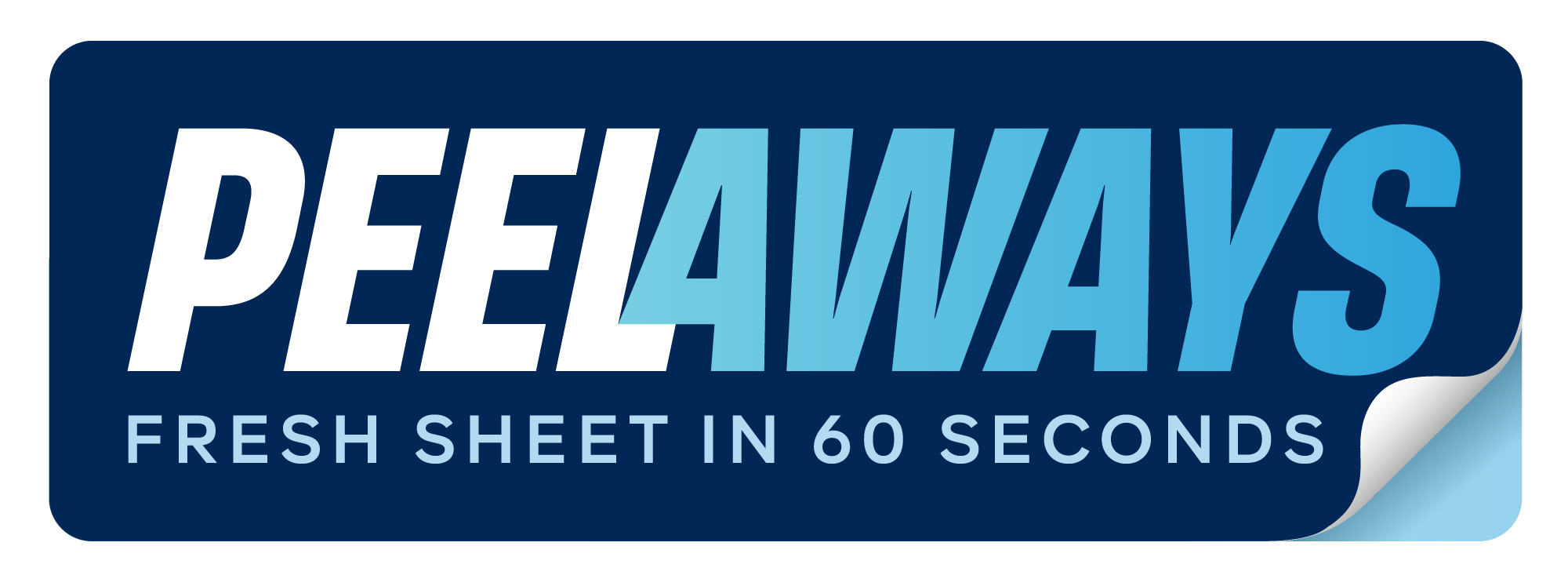Reusable vs. Disposable Bedding in Group Homes

Choosing the right bedding for group homes impacts hygiene, efficiency, and resident care. Here's a quick breakdown:
- Reusable Bedding: Cost-effective over time but labor-intensive. Requires laundering, which can lead to cross-contamination if mishandled. Offers a soft, familiar texture but demands significant water, energy, and staff time.
- Disposable Bedding: Simplifies care with peel-away layers that reduce handling and infection risks. Saves time, eliminates laundry, and offers convenience, though upfront costs are higher. Products like PeelAways include waterproof, breathable designs for added comfort.
Key Takeaway: Reusable bedding suits facilities prioritizing cost savings, while disposable bedding excels in infection control and ease of use. Your choice depends on your group's needs, resources, and priorities.
Infection Control Basics for Healthcare Laundry Services: Part 1
Hygiene and Infection Control
In group homes, where residents often face chronic health issues or weakened immune systems, bedding plays a critical role in controlling infection. The choice between reusable and disposable bedding can significantly impact how pathogens spread and how effectively contamination is managed.
Reusable Bedding: Hygiene Concerns
Reusable bedding presents several challenges when it comes to maintaining hygiene. Mistakes during laundering can leave behind pathogens, leading to persistent odors and stains. Delays in washing only worsen the problem, allowing bacteria to thrive. Additionally, handling soiled linens increases the risk of transferring contaminants to other surfaces or residents. A common issue with reusable sheets is liquid seepage, which can soak into mattresses, creating a breeding ground for germs and making cleanup even more difficult. Caregiver Jalene Stanger summed it up well:
"No more 15 loads of laundry and wet mattresses!"
Similarly, Ronda, another caregiver, highlighted the relief of moving away from reusable bedding:
"No more scrubbing, no more smell, and no more embarrassment."
The labor-intensive process of managing reusable bedding can also lead to delays in changing sheets, particularly for bedridden residents. This delay can prolong exposure to pathogens, increasing health risks.
Disposable Bedding: A Cleaner Alternative
These challenges highlight the advantages of disposable bedding systems, such as those offered by PeelAways. Their multi-layer design provides a practical solution to contamination risks. Each sheet features 5 to 7 waterproof layers that can be peeled away one at a time when soiled, instantly revealing a clean, fresh surface without the hassle of laundering.
The 100% waterproof barrier prevents liquids from penetrating to the lower layers or the mattress, effectively containing contaminants. Stephanie Jackson, a user of disposable bedding, shared her experience:
"After peeling away the soiled top layer, no liquid seeped through - no odor, no residue."
The quick changeover process, which takes less than a minute, reduces the time residents spend on soiled surfaces. Discarding the soiled layer immediately also minimizes handling and lowers the risk of cross-contamination - a crucial benefit during outbreaks of illnesses like norovirus or the flu.
Healthcare guidelines often recommend disposable bedding in high-risk environments because of its reliable infection control capabilities. Disposable bed pads, for instance, absorb liquid up to three times faster than some traditional options[3]. This rapid absorption keeps moisture from lingering on residents' skin, reducing the chances of bacterial growth.
For group homes caring for residents with incontinence, limited mobility, or weakened immune systems, disposable bedding offers a cleaner, safer solution. Its waterproof protection, fast absorption, and reduced risk of cross-contamination create a healthier environment, while also simplifying care processes - a topic explored further in later sections.
Cost and Daily Operations
When it comes to bedding choices, group homes need to think beyond the upfront price tag. The real financial impact lies in the total cost of ownership - a calculation that includes labor, utilities, inventory management, and day-to-day efficiency. These factors are crucial for budgeting and can significantly influence daily operations. Comparing reusable and disposable bedding highlights the recurring costs tied to each option.
Cost Breakdown of Reusable Bedding
Reusable bedding might seem economical at first glance, but the ongoing costs can quickly add up. Laundry is a major expense, especially since sanitization requires hot water washes, which consume significant amounts of energy and water. On top of that, the process demands a lot of staff time and effort.
Managing reusable bedding also introduces logistical challenges. Staff must strip, wash, and remake beds, all while keeping track of items as they move through cleaning and usage cycles. Over time, repeated high-temperature washes wear down the fabric, leading to frequent replacements - a hidden cost that often gets overlooked.
Cost and Time Savings with Disposable Bedding
Disposable bedding offers a more streamlined and cost-effective alternative. Take systems like PeelAways, for example. These products simplify operations by cutting out most of the labor-intensive steps. Changing a disposable sheet takes less than a minute, and because there’s no need for washing, facilities save a significant amount on water and energy bills.
The time saved on laundry allows staff to focus more on resident care - a shift that improves both efficiency and quality of service. As one customer, Kalahiki Jr Samuel, put it, disposable sheets are "more convenient to use than sheets, less washing, just peel off soiled layer and throw out."
Another advantage is the built-in waterproof barrier in PeelAways products, which prevents liquids from soaking into mattresses. This reduces or eliminates the need for expensive mattress cleanings or replacements. Inventory management is also simplified: instead of tracking reusable bedding through multiple stages, facilities only need to keep a stock of new disposable sheets and discard used layers. Features like PeelAways' "Subscribe & Save" option make reordering effortless, further easing administrative tasks.
While the upfront cost of disposable bedding is higher - ranging from $30.99 for Crib-A-Peel sheets to $53.99 for King-size options - the savings on utilities, labor, and operational complexity often outweigh the initial investment. Plus, with each sheet offering 5 to 7 uses, the multi-layer design provides excellent value while maintaining hygiene standards.
From a budgeting perspective, the consistent per-sheet pricing makes costs predictable. Facilities can also respond to soiling incidents immediately, without waiting for laundry cycles or dealing with complicated inventory processes. When you factor in variables like how often bedding needs to be changed, local utility rates, and staff wages, many group homes find that disposable bedding delivers not just convenience but also long-term financial benefits.
Comfort and Resident Care
In group homes, bedding plays a crucial role in residents' sleep quality and overall well-being. The decision between reusable and disposable bedding impacts not only physical comfort but also emotional reassurance. By choosing the right option, administrators can create a supportive and nurturing environment for residents.
Comfort Features of Reusable Bedding
Reusable bedding, with its soft and quilted design, offers a familiar and comforting experience, especially for residents adjusting to group home life. These traditional options often include tuck-in sides, which help keep the bedding securely in place throughout the night, providing a sense of stability and ease[3].
While the soft texture of reusable bedding feels natural against the skin, repeated high-temperature washes can gradually wear down its softness. Despite this, reusable bedding remains an excellent choice for those who prefer the feel of classic textiles. However, disposable bedding systems bring their own set of advantages when it comes to practicality and comfort.
Practical Comfort Benefits of Disposable Bedding
Disposable bedding, such as PeelAways, offers a modern approach to comfort. These sheets are designed with a unique blend of fibers that mimic the softness of traditional bedding while providing added practicality. Users frequently praise PeelAways for being comfortable, leak-proof, and quiet during sleep.
A breathable membrane in the sheets prevents liquid penetration while allowing air circulation, keeping beds cool and dry throughout the night[1]. Additionally, the sheets are formulated to be noiseless, eliminating the disruptive crinkling sounds often associated with disposable materials[1]. With no harsh chemicals used in their production, these sheets are safe for prolonged skin contact.
The multi-layer design of disposable bedding enhances both hygiene and comfort. These sheets can absorb liquids up to three times faster than many traditional options[3]. The quick-change feature allows caregivers to remove soiled layers instantly, minimizing downtime and preserving residents' dignity. Customizable sizing options, such as Crib-A-Peel for $30.99 or King-size for $53.99, ensure a snug fit for various bed types, further enhancing the sleeping experience[1].
This emphasis on comfort aligns with the broader mission of improving residents' quality of life in group homes. By carefully considering bedding options, administrators can make choices that prioritize both practicality and the well-being of their residents.
sbb-itb-45288fe
Environmental Impact and Waste
Selecting bedding for group homes involves weighing resource use against waste generation. Each choice comes with its own set of trade-offs that need thoughtful evaluation. Striking this balance is an important aspect of managing facilities over the long term.
Environmental Impact of Reusable Bedding
Reusable bedding stands out for producing very little physical waste, thanks to its ability to be used multiple times. For instance, a washable bed pad can hold up to 5,000 ml (about 1.3 gallons) of liquid and endure laundering at temperatures as high as 194°F.
However, this option shifts the environmental burden to water and energy use. Each wash requires a considerable amount of water, electricity to heat it, and chemical detergents. When scaled to the level of industrial laundry operations - often necessary in group homes with multiple residents - this can lead to significant water consumption. Additionally, the detergents and bleaching agents used may contribute to chemical runoff, posing challenges for water treatment systems.
Eco-Friendly Features of Disposable Bedding
Disposable bedding takes a different approach, focusing on reducing resource use. A notable example is PeelAways, which eliminates the need for laundering altogether. The company highlights how this can help caregivers and parents "save a lot of money and water on laundry" [1].
PeelAways sheets are designed without vinyl, PVC, phthalates, or fire retardants, limiting the release of harsh chemicals into the waste stream [1]. Their multi-layer design includes 5 to 7 soft, absorbent layers, allowing users to peel away only the top layer when soiled. This reduces the frequency of laundering and, consequently, the associated water, energy, and chemical use.
While disposable bedding does create physical waste, it avoids the ongoing resource demands of washing. For group homes in areas with limited water supply or those aiming to cut utility usage, this trade-off might better align with their environmental priorities.
Staff Training and Procedures
Building on the earlier discussion of operational and hygiene benefits, staff training requirements reveal another key difference between reusable and disposable bedding systems. Training needs vary significantly depending on whether group homes use reusable or disposable bedding, influencing both the initial learning curve and ongoing supervision.
Training for Reusable Bedding Management
Using reusable bedding demands detailed training to ensure proper handling and prevent cross-contamination. Staff must learn protocols for securely transporting soiled linens, following hot water washing guidelines, and storing clean linens correctly. Traditional laundering processes not only consume significant amounts of water and energy but also pose risks if linens are mishandled, allowing pathogens to survive even after washing[2]. Additionally, managing laundry schedules, maintaining equipment, and tracking inventory add layers of complexity to every bed change.
Simple Procedures for Disposable Bedding
Disposable bedding, such as PeelAways, simplifies training with an easy-to-follow three-step process: place the fitted sheet, peel off the soiled layer, and dispose of it. This approach allows staff to change a sheet in less than a minute without needing to strip the entire bed[1]. This simplicity reduces the chances of procedural errors and streamlines daily operations.
Caregiver feedback highlights how straightforward the process is. One caregiver shared:
"They said it is more convenient to use than sheets, less washing, just peel off soiled layer and throw out." – Kalahiki Jr Samuel[1]
This ease of use often empowers residents to handle the process themselves, lightening the workload for staff while fostering independence and dignity. The fully disposable design eliminates concerns about laundering and cross-contamination, further reducing the need for extensive training.
Comparison Table: Reusable vs. Disposable Bedding
Here's a breakdown of how reusable bedding stacks up against disposable options like PeelAways:
| Factor | Reusable Bedding | Disposable Bedding (PeelAways) |
|---|---|---|
| Initial Cost | $20–$40 per pad/sheet [3][4] | Starts at $30.99 [1] |
| Long-term Cost | Cheaper over time [3][4] | Costs add up with frequent replacements [3][4] |
| Absorbency | Up to 5,000 ml (1.3 gallons) per pad [3] | Varies by layer; includes waterproof backing |
| Hygiene Control | Risk of cross-contamination during washing | Prevents cross-contamination with peel-away layers |
| Staff Training | Requires detailed handling, washing, and storage protocols | Simple 3-step process: place, peel, dispose |
| Bed Change Time | Involves full stripping and remaking | Takes less than a minute; no bed stripping needed [1] |
| Laundry Requirements | Needs regular washing, drying, and folding | Eliminates laundry entirely [1] |
| Comfort Level | Softer, quilted, and feels more like home [3][5] | Improving with softer fabric layers |
| Environmental Impact | Uses water and energy for washing | Fully disposable, some biodegradable options available |
| Storage Needs | Requires space for clean and soiled linens | Compact storage, no inventory tracking required |
| Resident Independence | Usually needs staff assistance for changes | Often allows residents to handle changes themselves |
This table highlights the main differences to help you make an informed choice. Reusable bedding offers a familiar, cost-effective option over time, while disposable bedding like PeelAways shines in infection control and ease of use. Each option has its strengths, depending on your facility's priorities.
Conclusion: Choosing the Right Bedding for Group Homes
When deciding on bedding for group homes, it's essential to weigh hygiene, cost, comfort, and practicality to match your facility's priorities. Both reusable and disposable bedding have their strengths, and the right choice hinges on your operational needs and management style.
Hygiene and infection control are key factors. Disposable bedding, like PeelAways, excels in preventing contamination with its waterproof layers and single-use design. This makes it particularly effective during outbreaks or when caring for residents with weakened immune systems. Its ability to prevent seepage, odors, and contamination ensures a clean and safe environment.
Operational efficiency is another area where disposable bedding stands out. Unlike reusable options, which require extensive time for laundering and bed-making, disposable bedding can be replaced in under a minute without the need to strip the entire bed. For facilities with limited laundry capacity or high staff turnover, this time-saving feature allows staff to focus more on direct resident care.
Cost is another consideration. While reusable bedding may seem economical over time due to repeated use, disposable bedding eliminates ongoing expenses like water, electricity, detergent, and labor. This makes it a practical choice for facilities looking to streamline operations and reduce overhead.
Resident comfort is equally important. Modern disposable bedding has evolved to offer soft, breathable, and quiet surfaces, ensuring a good night's sleep. Products like PeelAways also allow residents to handle accidents independently, promoting dignity and self-reliance.
Ultimately, the decision comes down to your facility's specific needs. Whether prioritizing infection control, operational efficiency, or resident comfort, disposable bedding has proven to be a reliable option. With over 8,000 satisfied customers and an average rating of 4.8 [1], PeelAways demonstrates that disposable bedding can deliver hygiene, convenience, and comfort without compromise, making it a strong contender for group home settings.
FAQs
What are the benefits of using disposable bedding in group homes compared to reusable bedding?
Disposable bedding like Peelaways brings practical advantages to group homes, streamlining care routines and improving hygiene. These sheets feature a patented multi-layer design that allows you to peel off the soiled top layer, instantly revealing a clean sheet underneath - no need to lift the mattress or deal with laundry.
This approach saves valuable time and minimizes the risk of cross-contamination, creating a cleaner, safer environment for both residents and caregivers. Plus, Peelaways are soft, breathable, and completely waterproof, offering a balance of comfort and functionality to meet the diverse needs of group home care.
How can disposable bedding help protect residents with weakened immune systems from infections?
Disposable bedding provides a practical solution for improving infection control, particularly for individuals with compromised immune systems. Products like Peelaways offer multiple layers, each delivering a fresh and clean surface to minimize the chances of cross-contamination. When a layer gets soiled, it can simply be peeled off and thrown away, removing the need for washing or mattress cleaning.
This straightforward approach not only streamlines caregiving tasks but also helps maintain a sanitary environment, making it especially useful in group homes and care settings where health and safety are top priorities.
What are the long-term cost benefits of using disposable bedding instead of reusable bedding in group homes?
Using disposable bedding, such as Peelaways, can lead to noticeable savings over time by cutting out the constant need for laundering. Think about it - no more hefty bills for water, electricity, detergents, or the labor involved in washing and drying traditional bedding.
On top of that, disposable bedding makes life easier for caregivers. Instead of wrestling with sheets, they can simply peel off a soiled layer to reveal a fresh one underneath. This not only saves time but also reduces the physical effort of lifting mattresses. Plus, it helps keep the environment cleaner by lowering the chances of cross-contamination.
Related Blog Posts
- Disposable vs. Washable Bed Sheets: Comparison
- How Disposable Sheets Reduce Cross-Contamination
- Ultimate Guide to Incontinence Bedding Disposal
- Best Waterproof Hypoallergenic Bedding for Incontinence
Comments
1
hospitality linen suppliers
Cotton World supplies bed and bath linen to aged care centres, hotels, and hospitals across Australia. Commercial Linen Suppliers in Brisbane, Australia
https://cottonworld.com.au/

SAVE MONEY & WATER
Professionals & Institutions save a fortune on labor/laundry.

SUPERIOR COMFORT
The first thing our customers notice is how soft our sheets are.

100% WATERPROOF
Each layer is 100% Waterproof, perfect for spills and accidents

SAVE TIME
Change the sheet in under 1 minute without stripping the bed.




Leave a comment